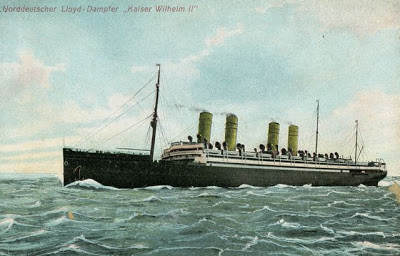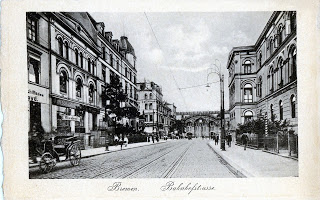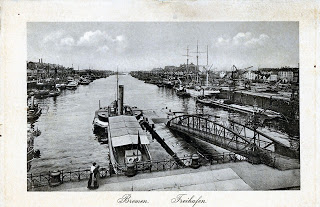Bremen, Germany, was the gateway for millions of emigrants from Central and Eastern Europe to American. So it was for my grandparents. Josef had already left for America on New Year’s Eve, 1910, and now was waiting for his sweetheart, Lisi, to join him in Chicago.
As we saw in the last post, Lisi spent three nights in Bremen before heading to the port and the ship that would take her to America. She wrote nothing of her feelings about this momentous occasion, only the schedule details:
Arrival in Bremen Saturday, 9/16/11
9/19/11 8:00 a.m. Depart [Bremen]
Like Josef did nine months earlier, she was taking a train from the city of Bremen to the Bremen Port, Bremerhaven, about thirty miles south. These two postcards, mementoes in our archives which I assume she purchased during her stay a century ago, are the only clues I have of what she saw in those two days and three nights.
One depicts Bahnhofstrasse (literally, “Train Station Street”) in the heart of Bremen. The other is of Bremen Port. There she must have seen seagulls for the first time, and writes that “Seagulls look like doves, only bigger.” It’s the only comment she makes about her surroundings or the life-changing voyage she is about to embark upon.
While it doesn’t surprise me that my grandmother, Lisi, didn’t write much of her emotions, (I remember her as an exceedingly practical person), I was struck by the contrast between her diary and that of my grandfather. Grandpa’s diary has given me an entirely new view of him. We always saw his joking, teasing, funny side, but through his letters and diary, I have discovered he was also romantic and in touch with his feelings.
As his ship, Friedrich der Grosse, pulled away from shore nine months earlier, on December 31, 1910, he wrote from his heart:
I was moved by sadness, joy, and fear as the mighty colossus pulled us far out over the waves of the great sea. Everyone on land waved after us with their handkerchiefs as they wanted to share with us a last and friendly farewell. They know such a trip deals with life and death, and we’re never certain if we’ll see each other again. (See Out to Sea).
Lisi must have observed a similar scene when she boarded her ship, Kaiser Wilhelm II, but wrote nothing about it. However, she did save this wonderful postcard of KWII, noting details of her arrival on the back (more on that coming up). In the upper left is written: “Norddeutscher Lloyd Dampfer “Kaiser Wilhelm II.” Norddeutscher Lloyd (North German Lloyd) was the shipping company that owned the ship. Dampfer means steamer.

Kaiser Wilhelm II—the ship that brought Elisabetha (Lisi) Ebner, my grandmother, to America, departing Bremenhafen 9/19/1911
Once she was on the ship, Lisi again made no commentary on her experiences: whom she met, what the weather was like, what her fears or hopes were. Instead her diary is dominated by what she eats! As prosaic as that sounds, what these entries do reveal is what I believe is Lisi’s amazement at the incredible quantity and variety of food she can choose from. It also shows that her ocean voyage was clearly at a higher class than that of my grandfather, Josef. He had traveled steerage (the cheapest ticket, in the bowels of the ship. No food included).
In his diary he had written:
Another problem on the ship was eating. As long as I had mother’s bread and wurst, it was ok, but when I had eaten all that, I just stood there and didn’t know how to get something to eat because the cost [of food] is miserable on the ship. (See Out to Sea)
In contrast, Lisi’s trip is marked by a bounty of food. The first day she boards the ship on September 19th, 1911, she devotes her entire entry to the menu choices:
Soups:
semolina
asparagus [or]
cauliflower
Main courses:
Fish baked with lemon and Potato salad
Steamed beef with horse radish or gravy and roasted potatoes and steamed/stewed cabbage [or]
Baked duck with apple compote and salad
Dessert
Ice cream
vanilla cream (like custard)
pudding
apples, oranges [or]
pastries
coffee.
Evening meal:
Veal liver or
Chopped schnitzel (minced meat—maybe like hamburger meat) and roasted onions
Pudding.
Every day, Lisi compulsively recorded the food, drinks, and snacks she consumed. But she also noted several purchases, as she kept track of expenditures. Her desire to record and save details of her and her family’s life, even if mundane, has been a boon to my ability to puzzle out my family’s history.
On the next post: the records Lisi did keep—and the clues they provide to piecing together to the provenance of several century-old artifacts and documents.


I continue to be fascinated by the information you’re sharing. My grandmother departed from Bremen as well. I’m learning a lot! Thank you!
Amazing the amount of detail she left for you!
My g-grandfather left from that port in 1881 at the age of seven. My husband and I had the opportunity to visit Bremerhaven a few years ago. They have an emigration museum there — I have pictures. How lucky Lisi was to not have to travel steerage.
I agree she was lucky not to go steerage — not great for anyone, much less for a woman alone. I’m not sure if my grandfather sent her money for the better voyage, if she had saved it, or even if her employer, the wealthy Mrs. Jickeli, had helped out. More on other help Mrs. Jickeli gave in a future post.
That menu! My goodness. That’s nicer than any restaurant I’ve been to in quite a while.
What a revealing contrast between Lisi & Josef’s crossing notes!
Key, Kerry, I agree–I am quite sure on e reason she wrote all this down is that the menu was amazing to her too. Candace — I can’t tell you how surprised I was to learn how my grandfather expressed himself!